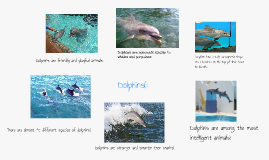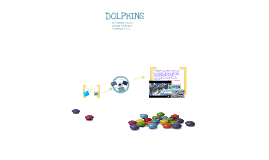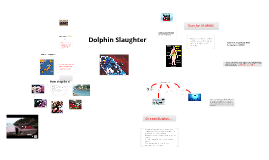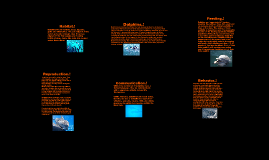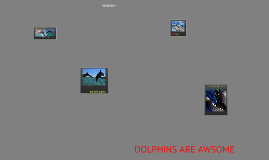Dolphin
Transcript: Dolphins.! Dolphins are marine mammals that are closely related to whales and porpoises. There are almost forty species of dolphin in 17 genera. They vary in size from 1.2 m (4 ft) and 40 kg (90 lb) (Maui's dolphin), up to 9.5 m (30 ft) and 10 tonnes (9.8 long tons; 11 short tons) (the orca or killer whale). They are found worldwide, mostly in the shallower seas of the continental shelves, and are carnivores, mostly eating fish and squid. The family Delphinidae is the largest in the Cetacean order, and evolved relatively recently, about ten million years ago, during the Miocene. Dolphins are among the most intelligent animals, and their often friendly appearance and seemingly playful attitude have made them popular in human culture. Reproduction.! dolphins can court or play for days. They swim together and pet each other with their fins. The actual mating is brief and it lasts only one to two seconds. Reproduction normally occurs during the spring months. Males make elaborate swimming patterns and calls. Whether this is done to show off their fitness or to show other dolphins that he has coupled with a female is unknown. Females have a short period in every few years when they are fertile. Gestation takes between 11 to 12 months. Gestation is how long the female dolphin is pregnant. The delivery of the baby dolphin is usually tail first, because if the calf is born head first, it won't be able to get to the surface in time to breath. Female dolphins can retain the ability to produce milk long after they lose the ability to make babies. Inexperienced females will care for the calves of other females to gain experience. Feeding.! Communication.! While it is not known if dolphins have a formal language, they do communicate with a signature whistle to identify themselves. Unlike humans, dolphins lack vocal cords, but they do use a complicated system of whistles, squeaks, moans, trills and clicks produced by sphincter muscles within the blow hole. Habitat.! Dolphins live in harbors, bays, lagoons, gulfs and tributaries. They do migrate if the water gets cold enough. Also they may migrate if the fish supply and feeding habits change. Some like cold and deeper water than others. Behavior.! Dolphins can leap above the water surface and perform acrobatic figures (e.g. the spinner dolphin). Scientists aren't quite certain about the purpose of this behavior, but it may be to locate schools of fish by looking at above water signs, like feeding birds. They could also be communicating to other dolphins to join a hunt, or attempting to dislodge parasites. Perhaps they just do it for fun. Play is a very important part of dolphins' lives and they can often be observed playing with seaweed or playfighting with other dolphins. They have even been seen harassing other creatures, like seabirds and turtles. Frequently dolphins will accompany boats, riding the bow waves. Dolphins are “opportunistic” feeders, meaning they will eat those fish, squid and crustaceans (such as shrimp) available to them at that time. The variety of foods available is dependent upon the geographic location of the feeding population. Dolphin populations living along coastal areas tend to eat fishes and invertebrates which live on the coastal bottoms. Dolphins living in deeper parts of the oceans tend to eat fishes and squid which swim in the marine mid levels. Adult dolphins eat about 15-25 pounds of food per day (about 4-6% of their body weight), with nursing cows eating over 30 pounds per day (about 8% of their body weight).






